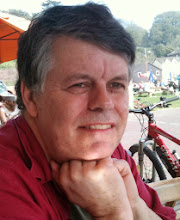 Steven Appleby managed to get my frustration about spiders webs of mic cables off to a tee.
Steven Appleby managed to get my frustration about spiders webs of mic cables off to a tee.
Monday, 27 June 2011
Thursday, 6 January 2011
£4.33 for 4'33"
I was tickled when I bought my John Cage score (Letters, 3 January) at a performance at the Barbican a few years ago – it was priced at £4.33.
Iain Fraser
Bedford
Monday, 3 January 2011
3 versions of 4'33"
Here's what it had to say:
The so-called First Tacet Edition: a typewritten score, lists the three movements using Roman numbers, with the word "TACET" underneath each. A note by Cage describes the first performance and mentions that "the work may be performed by (any) instrumentalist or combination of instrumentalists and last any length of time." Edition Peters No. 6777 (out of print).
The so-called Second Tacet Edition: same as the First, except that it is printed in Cage's calligraphy, and the explanatory note mentions the Kremen manuscript. Edition Peters No. 6777 (i.e. it carries the same catalogue number as the first Tacet Edition)
The Kremen manuscript (1953): graphic, space-time notation, dedicated to Irwin Kremen The movements of the piece are rendered as space between long vertical lines; a tempo indication is provided (60), and at the end of each movement the time is indicated in minutes and seconds EP No. 6777a.
The premiere of the three-movement 4'33 was given by David Tudor on August 29, 1952, at Woodstock, New York as part of a recital of contemporary piano music. The audience saw him sit at the piano and, to mark the beginning of the piece, close the keyboard lid. Some time later he opened it briefly, to mark the end of the first movement. This process was repeated for the second and third movements. The piece had passed without a note being played—in fact without Tudor (or anyone else) having made any deliberate sound as part of the piece. Tudor timed the three movements with a stopwatch while turning the pages of the score.
"They missed the point. There's no such thing as silence. What they thought was silence, because they didn't know how to listen, was full of accidental sounds. You could hear the wind stirring outside during the first movement. During the second, raindrops began patterning the roof, and during the third the people themselves made all kinds of interesting sounds as they talked or walked out." - John Cage speaking about the premiere of 4'33".
For a full history of 4'33" visit the wikipedia entry here: http://en.wikipedia.org/wiki/4'33"
Responses on 4'33"
Julian Oddy (Letters, 1 January) has a very good chance of buying the score of John Cage's 4' 33" – a copy was prominently displayed in Foyles just before Christmas. I was quite tempted myself, but my sight reading is hopeless.
Tim Davies
London
It can be bought from Peters, whose website explains the difference between the three versions they have published (two in print, one out of print).
Andrew Mitchell
London
It's in three movements, each marked "tacet".
Jason Hazeley
London
Guardian reviews "The Wire"
Watson described the noise as "some of the strangest and most beautiful sounds I've ever heard", adding that as he listened to it there were "six or seven grey kangaroos" in front of him. He was in Australia, where artist-led Wired Lab Project celebrates this aural phenomenon.
There was an intensity to the way the artists explained their passion, and a smidgeon of the geek as they detailed the technical process of recording the odd hum. One chap recalled recording the noise all night; another suggested the sound was akin to "the sound of a cell".
But there was magic, too. As we listened to the wind strumming the wire, the sound suddenly contracted and went high-pitched. "All the sound just changed completely," we heard. "It's because the sun came out." Watson, who knows all about the power of sounds to convey a moment, place or creature, was mesmerised by the interplay of weather and wire, and the brooding poetry it can make.

Sunday, 2 January 2011
The Music of the Wires
The BBC website has more information and links, including the Wired Lab Project.
Now where are my Alan Lamb CDs filed? Sound Art? Environmental recordings? Modern Music? And physical of hidden on my laptop?
Saturday, 1 January 2011
A score for John Cage's 4'33"?
A short time ago you published my letter asking where I could purchase a copy of the British Constitution - sadly to no avail. I should now like to buy the score of John Cage's 4'33". Will I have a better chance?
Julian Oddy
Weymouth, Dorset
Of course he does. Here's my response.
Dear Sir
Why does Julian Oddy think that it is impossible to notate John Cage's 4'33".
I bought my copy of the score [in 3 movements] several years back, along with a copy of it on a T-shirt which I've been wearing proudly over the past few weeks, from his publishers Edition Peters.
Yours faithfully
Paul Bull
Exeter, Devon

